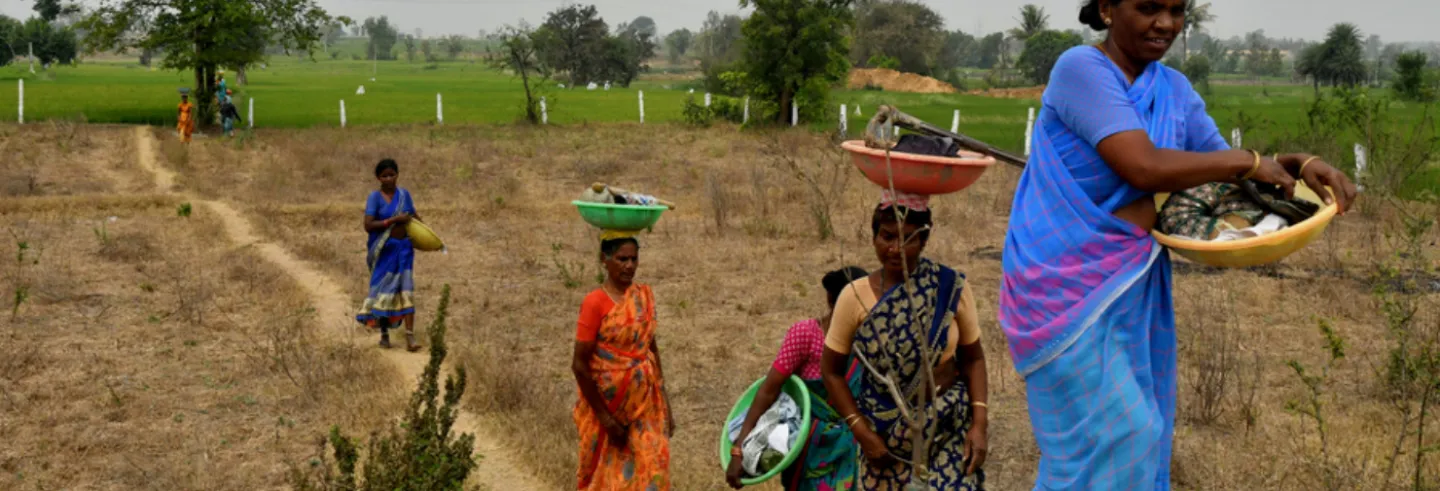The history of the Mahatma Gandhi National Rural Employment Guarantee Act (MGNREGA) in Telangana, the state that was formed in 2014 when Andhra Pradesh was bifurcated, reflects its pivotal role as a social security programme. The state continued the worker-friendly provisions it inherited from undivided Andhra Pradesh, providing crucial support to rural workers.
However, recent policy changes and budget cuts by the union government have affected the MGNREGA’s performance in Telangana. This article explores the challenges faced by the programme in the state after the pandemic, shedding light on the interplay of policies, technology, and socio-economic shifts in Telangana’s MGNREGA journey. The information used for this analysis has been obtained from the MGNREGA website (https://nrega.nic.in/) and reflects data up to 26 September 2023.
1. MGNREGA in Telangana
The MGNREGA is a crucial social security programme in India, ensuring 100 days of wage employment a year for adult members in registered rural households. Undivided Andhra Pradesh played a significant role in the MGNREGA, contributing substantially to wages and introducing innovative technological and civil society interventions.
The state pioneered an e-governance model, implemented a robust social audit system, organised workers into labour groups, and used a web-based management information system (MIS) for the programme’s work, actively engaging civil society organisations in monitoring its implementation. The incorporation of some of these worker-friendly provisions was the result of the influence exerted by civil society organisations.
The newly formed Telangana state assembly rejected [in 2014] the Union Government’s proposal to limit the MGNREGA to 2,500 backward blocks of the country, which would have reduced the coverage from 442 revenue mandals to 78 in the state.
In 2014, Telangana inherited a relatively successful MGNREGA model from undivided Andhra Pradesh. On 17 November 2014, the newly formed Telangana state assembly rejected the union government’s proposal to limit the MGNREGA to 2,500 backward blocks of the country, which would have reduced the coverage from 442 revenue mandals (blocks) to 78 in the state. Despite the bifurcation, Telangana retained several provisions that favoured workers such as paying them a summer allowance and organising them into labour groups.
We delve below into the challenges posed by the union government’s policies, including technological changes, to implementing the programme in Telangana. We will specifically explore the implications of budget cuts on the MGNREGA’s outcomes; the financial conflict arising from the union government’s demand for reimbursement; and the impact of the shift to the National Informatics Centre (NIC) on worker-friendly measures. In addition, we will address the complexities associated with the National Mobile Monitoring System (NMMS) and the challenges posed by the revised Aadhaar-based payment system (ABPS), which was introduced in 2022.
2. Mandates and Challenges
Policy changes and technological shifts implemented by the union government, alongside budget cuts, have adversely impacted the implementation of the MGNREGA in Telangana in recent years.
2.1 Budgetary shortfall
The MGNREGA relies predominantly on funding from the union government, covering 90% of its total allocation. The union government’s budget allocation is a key indicator of its commitment to implementing the MGNREGA, and Figure 1 indicates there has been a shortfall in the post-pandemic period. Despite a notable increase in gross domestic product (GDP), allocations as a proportion of it have steadily decreased, even falling below pre-pandemic levels. Several studies consistently link the budget allocation to employment opportunities, emphasising that budget cuts not only hinder programme outcomes but also cause significant payment delays.
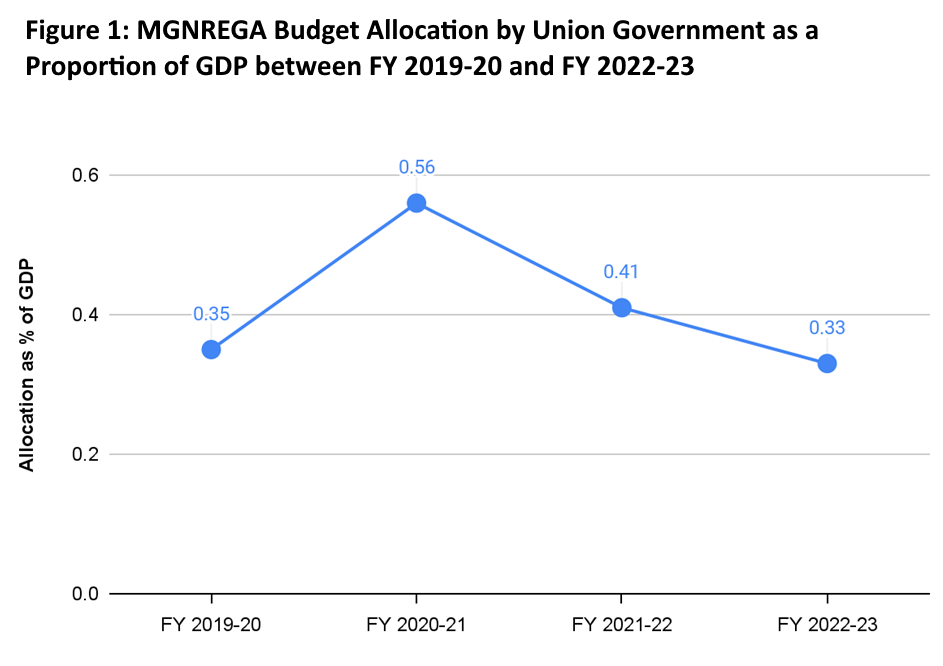
Telangana, like many other states, grapples with challenges because of insufficient funds, highlighting how important an adequate budget allocation is for the seamless operation of the MGNREGA (Narayanan et al. 2020).
2.2 Financial tussle
In the latter part of 2022, the union government issued a notice demanding that the Telangana government pay it Rs.151.9 crore as reimbursement for constructing fish/grain drying yards under the MGNREGA though they are not a part of the works permitted by the programme. This followed a report from a central team in June 2022, which inspected works in Kamareddy, Nalgonda, Khammam, Janagam, and Hanmakonda districts. The union government withheld MGNREGA funds, saying it would be released after the reimbursement was received.
The withholding of funds by the union government not only heightened political tensions between the then ruling Bharat Rashtra Samithi and the Bharatiya Janata Party in Telangana but also inflicted hardships on workers.
This heightened tensions in the state and sparked a political conflict between the then ruling Bharat Rashtra Samithi (BRS) and the Bharatiya Janata Party (BJP), each vying for political influence in the state. BRS party workers organised protests against the Modi government across the state in December 2022, demanding that the reimbursement notice be withdrawn. The issue was eventually resolved with the state government paying Rs. 127 crore as reimbursement.
The withholding of funds by the union government not only heightened political tensions between the BRS and BJP in Telangana but also inflicted hardships on workers. The protests and negotiations underscored the adverse impact such financial tussles could have on the stability of the rural employment programme in the state.
2.3 Tech transition
a) Shift to National Informatics Centre (NIC): Following the pandemic, the Union Ministry of Rural Development imposed the centrally run management information system (MIS) on Telangana to implement, monitor, and maintain MGNREGA records, replacing the state-specific Ragas software. Ground-level interactions reveal that local officials have had difficulties in adapting to the new technology.
The forced shift to the NIC resulted in a transformation of the process of collecting work demands from workers, processing them in the MIS, and preparing them for payment. The transition meant the elimination of state-specific worker-friendly measures, which heightened centralisation. This curtailed the state’s autonomy to implement measures tailored to its unique geographic conditions (Buddha and Kagga 2023).
b) Implementing the National Mobile Monitoring System (NMMS) app: In Telangana, as elsewhere in the country, workers are grappling with significant challenges in the implementation of the NMMS app. Launched by the ministry of rural development in May 2021, the app is aimed at improving citizen oversight and transparency in works undertaken by the employment programme. The app is designed to record the real-time attendance of MGNREGA workers at a worksite.
Local NREGA Mates, women at the panchayat level specifically trained to monitor worksites, were entrusted with using the app to record the real-time, geo-tagged attendance of workers. However, complications have emerged because the app requires workers to be present at a fixed time, creating hurdles for workers accustomed to flexible hours. These issues, encompassing conflicting work schedules and connectivity problems, have disproportionately affected women workers, who constitute a significant majority in the programme. In addition, the prerequisite for NREGA Mates to own smartphones has excluded many eligible women from assuming leadership roles, sparking concerns about gender bias in the selection process.
c) Challenges with the revised ABPS system: The shifts in payment systems have been a source of hardship for workers. Following Telangana’s formation, the payment system underwent a transition from an Aadhaar-based payment system to an account payment system to align it with national standards. Subsequently, it reverted to the ABPS, presenting challenges for workers and frontline officials.
Even a minor discrepancy, such as mismatch in a single letter or a failure to update the UID in the last decade, results in authentication failure.
This was compounded by the challenges introduced with the 2022 revised ABPS (Buddha and Tamang 2023). In the previous iteration of the ABPS implemented in undivided Andhra Pradesh, workers’ bank account numbers were linked with their Aadhaar cards and the National Payments Corporation of India (NPCI) mapper. This well-established system underwent an overhaul in 2022 when there was a focus on Aadhaar integration from end to end. The updated version introduces Aadhaar seeding and Aadhaar authentication in addition to linking Aadhaar to an existing bank account.

Aadhaar seeding requires aligning each worker’s job card with their Aadhaar card and authentication involves cross-referencing details between the programme’s MIS and the Aadhaar card’s Unique Identification Number (UID). Even a minor discrepancy, such as mismatch in a single letter or a failure to update the UID in the last decade, results in authentication failure. Workers who pass these checks must link their bank accounts to their Aadhaar cards and undergo NPCI mapping—a process our field studies identified as challenging for workers.
Failing to comply with any of these three steps puts workers at the risk of missing employment and payments for their work. Moreover, the implementation of the ABPS without adequately training local officials has led to widespread deletions of worker’s names from the MGNREGA database in Telangana.
Table 1 provides information (as on 26 September 2023) on the total number of MGNREGA workers in Telangana, and the percentage of them ineligible for the ABPS.
3. Evaluating MGNREGA
Being a demand-driven employment programme, the MGNREGA should ideally reflect workers’ need for the scheme through the number of households employed and workdays generated. However, the union government’s tight control over budget allocations and differences in the political will or administrative capabilities of different states mean that employment-related numbers do not entirely reflect the demand for employment under the MGNREGA.
The numbers related to the employment provided, the participation of vulnerable communities, and budget utilisation are some of the key indicators to evaluate the performance of the MGNREGA.
3.1 Rise and fall in employment
Amid the challenges posed by the Covid-19 pandemic, the MGNREGA was a lifeline for rural households, especially for migrant workers, offering them crucial support when alternative options were scarce (Centre for Sustainable Employment et al. 2022; Narayanan et al. 2020). Table 2 illustrates the substantial increase in the number of households, the employment provided, and the average person days generated at a household level during 2020-21, a pandemic year. The total person days grew significantly by around 47.5%, with the average person days per household rising by nearly 17.6% between 2019-20 and 2020-21.

As with the national trend, post-pandemic, the state witnessed a contraction in the number of households worked, person days generated, and average days of employment (Table 2). This downturn emphasises the need for customised strategies to address the specific challenges faced by Telangana in sustaining rural employment through the MGNREGA.
However, it is crucial to note that though the employment generated in 2022-23 returned to pre-pandemic levels, indicating a good thing, this masks a significant concern. During on-site observations, we noted that the reduction in the MGNREGA budget after the pandemic disproportionately affected those involved in distress migration. These individuals returned to their villages during the pandemic and secured employment under the MGNREGA. However, they have now again left for towns and cities because the MGNREGA’s employment opportunities have declined.
3.2 Fluctuations in participation
a) Scheduled Castes/Scheduled Tribes (SC/ST) participation
The participation of SCs/STs in the MGNREGA in Telangana shows a positive trend of overrepresentation because it surpasses their census proportions of 17% and 9.1% respectively. Figure 2 illustrates that both the SCs and STs consistently secure a higher share of MGNREGA employment than their population percentages. An examination of the SC/ST employment share in the MGNREGA over the fiscal years 2019-20 to 2022-23 reveals only minor fluctuations in this pattern.
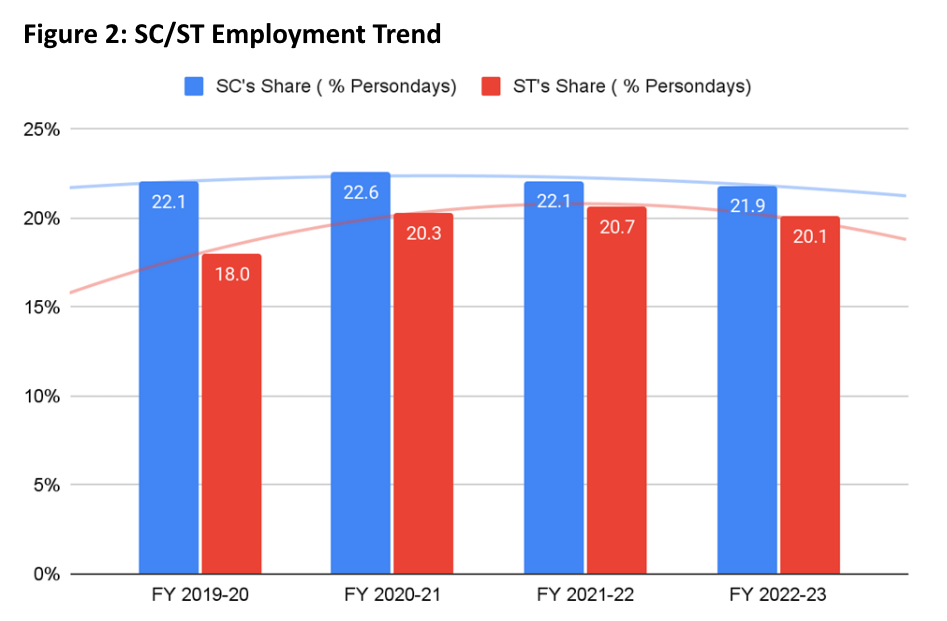
b) Women’s participation
With women accounting for 49.7% of Telangana’s population, their participation in the MGNREGA exceeds their demographic share. Despite marginal decreases in some years, their involvement remains a noteworthy constant amid demographic variations (Figure 3).
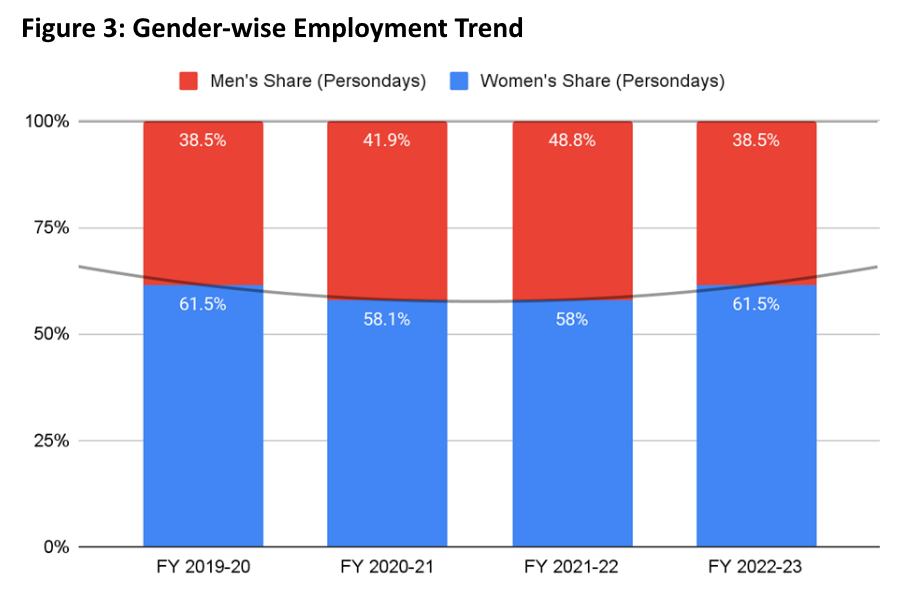
3.3 Job cards and Aadhaar
According to the ministry of rural development’s response in the Lok Sabha, the deletion of registered MGNREGA workers spiked by 247% in 2022-23 compared to the previous year, reaching 5.2 crore workers at the national level. As depicted in Figure 4, Telangana experienced a remarkable surge in the deletion of workers—from 0.51% of registered workers to 16.41%, totalling 17.3 lakh workers.
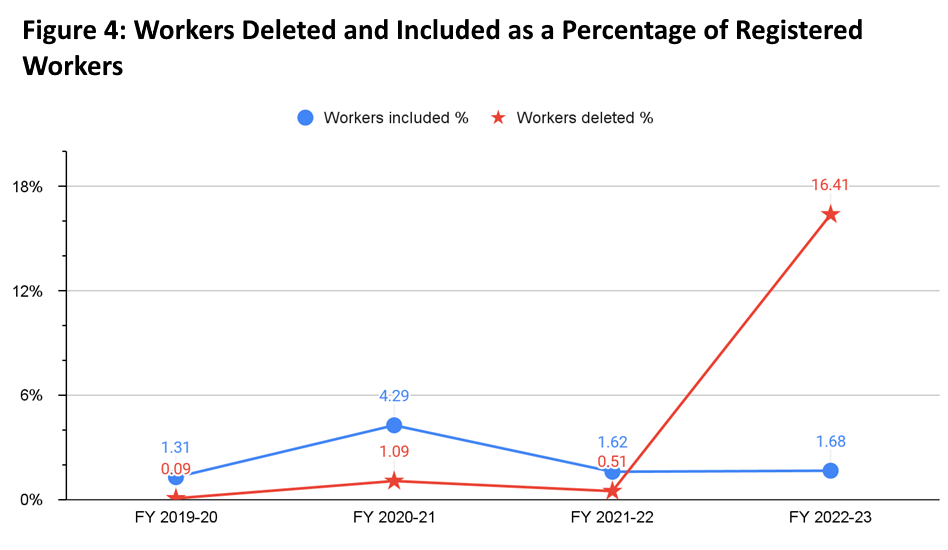
The Aadhaar-based payment system, mandatory from 1 February 2023, added complexity to the MGNREGA. Frontline officials, facing challenges in meeting the eligibility criteria of the ABPS, resorted to deleting worker names rather than addressing compliance issues. LibTech India’s field studies in districts such as Kumarabheem, Asifabad, Narayanpet, Jogulamba Gadwal, and Mulugu unveiled unauthorised deletions, prompting concerns about procedural fairness and transparency. Certain deletions appeared to be strategic, towards improving compliance with the Aadhaar-based payment system, but this only highlights the systemic challenges in its implementation.
3.4 Unravelling financial dynamics
Over the past four fiscal years, wage trends in the MGNREGA in Telangana have undergone significant fluctuations (Figure 5). In the fiscal year 2019-20, the wage expenditure was Rs. 1,684.57 crore, which serves as a baseline for subsequent analysis. There was a substantial surge in fiscal year 2020-21 with wage expenditure soaring to Rs. 2,666.69 crore—an increase of approximately 58%.
However, in the following fiscal year, 2021-22, there was a decline, reducing the expenditure to Rs. 2,420.13 crore. The latest data for fiscal year 2022-23 shows a further reduction, with the wage expenditure dropping to Rs. 2,032.58 crore. These fluctuations align closely with the union budget allocations for the MGNREGA.
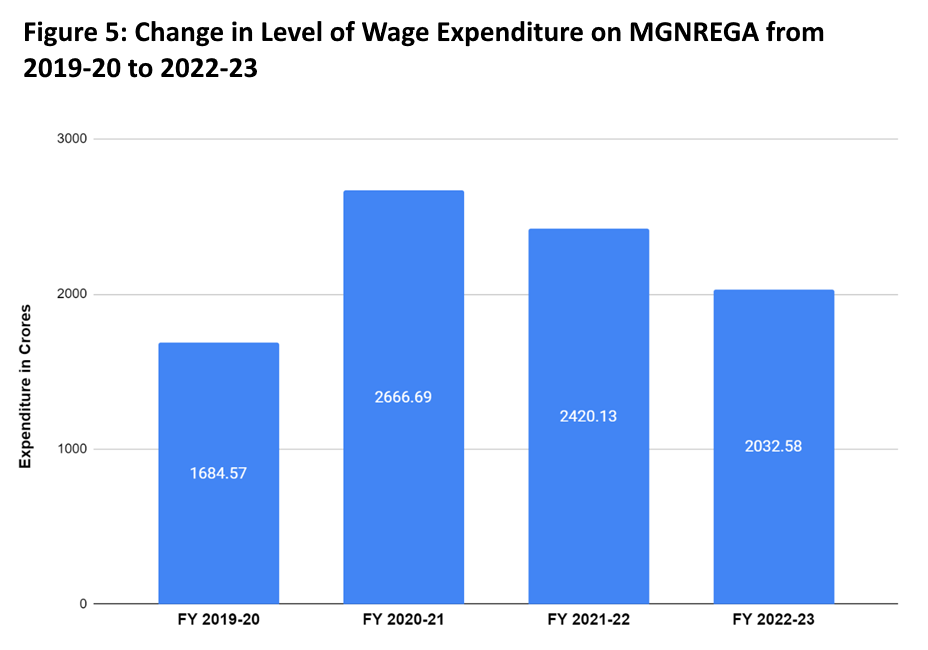
It is noteworthy that despite an increase in the NREGA wage from Rs. 211 in 2019-20 to Rs. 257 in 2022-23, the overall wage earnings of workers did not rise proportionately. This underscores that a complex interplay of factors influences wage dynamics.
Wage expenditure is primarily influenced by the number of households participating in the MGNREGA and the total number of days they work. It is important to highlight that both these factors have been negatively affected by lower budget allocations.
4. Conclusions
After the pandemic, Telangana's experience with the MGNREGA highlights a complex web of factors—government policies, technology, and shifting social and economic realities. While national initiatives were implemented, Telangana’s switch to the National Informatics Centre exposed concerns about excessive control and budget cuts by the Modi government. These cuts hurt employment and caused payment delays, even sparking conflicts like the union government’s demand for Rs. 151.9 crore in reimbursement.
Technological changes such as the revised ABPS and the full transition to it have led to challenges for workers, including deletions of their names from lists and increased centralisation. This demonstrates the need for a more balanced approach to technology implementation.
While the MGNREGA played a vital role during the Covid-19 period by providing a lifeline to rural households, the post-pandemic scenario reveals challenges exacerbated by central budget cuts and unilateral tech interventions. The fluctuations in wage expenditure underscore the changing financial landscape of the programme, which is determined by central policies.
Telangana’s MGNREGA faces tough choices. Budget cuts and technological changes from the centre ignore the need for solutions that fit local needs. Building a strong programme means involving communities, engaging people, and making sure policies help everyone, especially the most vulnerable. Timely payments, clear spending, and focus on livelihoods are key. To truly serve rural families, the MGNREGA in Telangana needs a smart, inclusive approach, adapting to challenges while staying true to its core mission—being a safety net for rural people.
Chakradhar Buddha is a senior researcher in LibTech India; Anuradha De is a researcher in LibTech and a director of Collaborative Research and Dissemination, New Delhi (CORD); and Diwakar Mantri is part of the Data Team in LibTech India.

